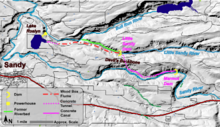Bull Run Hydroelectric Project
| Marmot Dam and Little Sandy Dam | |
|---|---|

Map of the components of the Bull Run Hydroelectric Project
|
|
| Official name | Bull Run Hydroelectric Project |
| Country | United States |
| Location | Oregon |
| Coordinates | 45°25′44″N 122°14′02″W / 45.42901°N 122.23395°WCoordinates: 45°25′44″N 122°14′02″W / 45.42901°N 122.23395°W |
| Purpose | Power generation |
| Status | Decommissioned |
| Construction began | 1908 |
| Opening date | 1912 |
| Demolition date | 2007-2008 |
| Owner(s) | Portland General Electric |
| Reservoir | |
| Creates | Roslyn Lake |
| Total capacity | 928 acre feet (1,145,000 m3) |
| Power station | |
| Installed capacity | 22 MW |
| Annual generation | 110,000 MW·h (400 TJ) |
The Bull Run Hydroelectric Project was a Portland General Electric (PGE) development in the Sandy River basin in the U.S. state of Oregon. Originally built between 1908 and 1912 near the town of Bull Run, it supplied hydroelectric power for the Portland area for nearly a century, until it was removed in 2007 and 2008. The project used a system of canals, tunnels, wood box flumes and diversion dams to feed a remote storage reservoir and powerhouse. The entire project was removed because of rising environmental costs. Marmot Dam on the Sandy River was demolished in 2007, and the Little Sandy Dam on the Little Sandy River was taken down in 2008.
The Mount Hood Railway and Power Company (MHR&P), also known as the Mount Hood Company, began the project in 1906, building the Little Sandy Dam to divert water through a wooden flume, about 3.2 miles (5.1 km) long, to Roslyn Lake. The dam reduced streamflows on the lower 1.7 miles (2.7 km) of the Little Sandy River and blocked all salmon and steelhead access to the upper 6.5 miles (10.5 km) of the river. Roslyn Lake was at 656 feet (200 m) above sea level, about 400 feet (120 m) higher than the mouth of the Bull Run River, at 242 feet (74 m). The 140-acre (57 ha) lake acted as a reservoir for the powerhouse, which was completed and put into operation in 1912, the same year that the MHR&P merged with Portland Railway, Light and Power Company (PRL&P), the predecessor of PGE.
In 1913 PRL&P built a dam on the Sandy River to supplement the Little Sandy Dam. The Marmot Dam, 45 feet (14 m) high, diverted water from the Sandy to the Little Sandy by canal and tunnel, the longest of which ran 4,690 feet (1,430 m) under the ridge between the two rivers. The new dam supplied up to 600 cubic feet per second (17 m3/s) to the Little Sandy above its diversion dam, and the Little Sandy provided up to 200 cubic feet per second (5.7 m3/s), all of which could be diverted through the flume to Roslyn Lake.
...
Wikipedia
